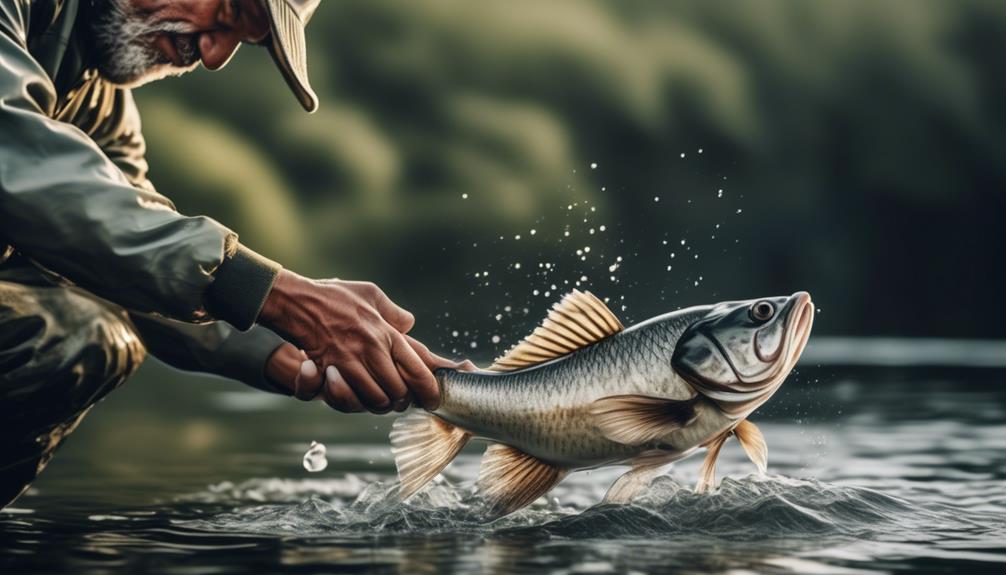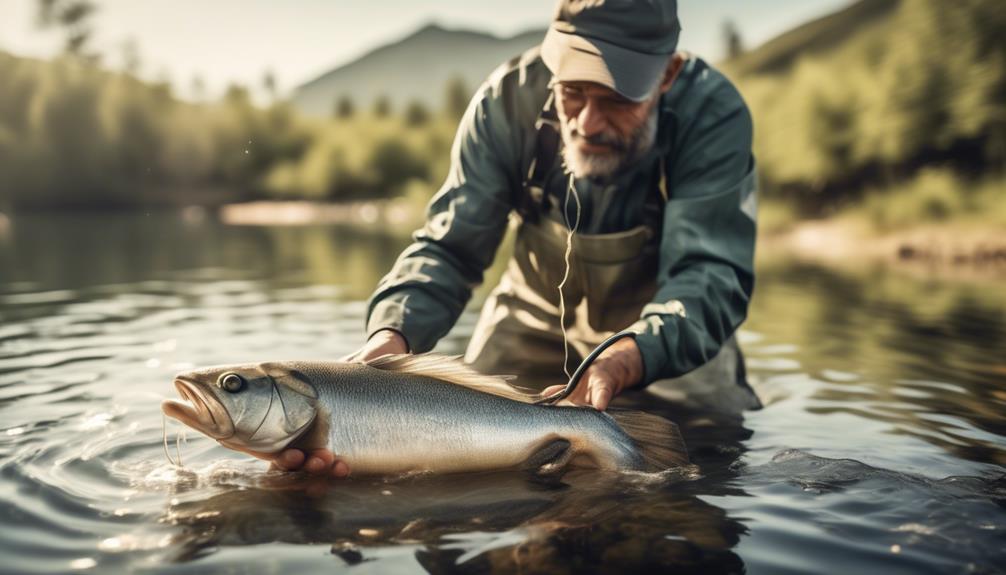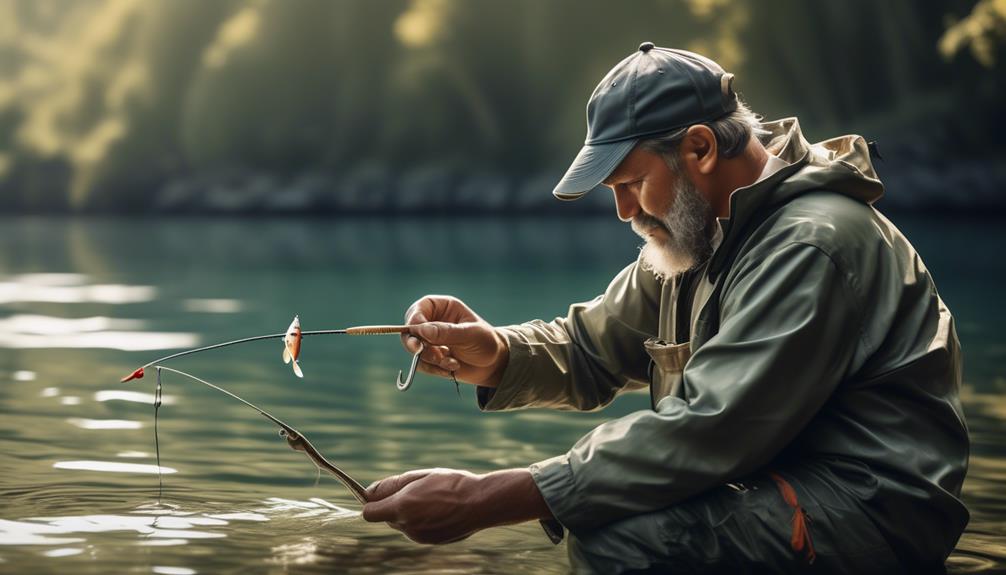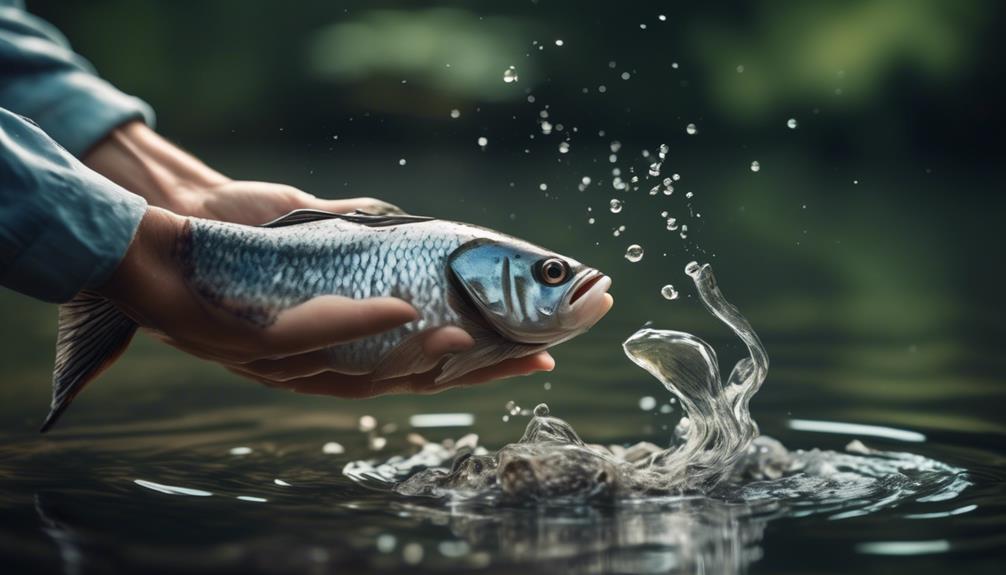You've probably heard that catch and release is a responsible way to enjoy fishing while protecting fish populations. But do you know the best practices to ensure the ethical treatment of the fish you catch?
Mastering the art of catch and release involves more than just tossing a fish back into the water. By following these 14 tips, you can enhance your ethical conduct and contribute to the conservation of aquatic ecosystems.
Whether you're a seasoned angler or new to the sport, these guidelines will help you make a positive impact on the environment and ensure the well-being of the fish you encounter.
Understanding Fish Stress
To understand fish stress, it's crucial to recognize the physiological and behavioral responses that occur when fish are subjected to various stressors. Fish, much like other animals, exhibit stress indicators that can help us understand their well-being. When stressed, fish may display changes in behavior such as reduced feeding, increased aggression, or erratic swimming patterns. Physiologically, stress can manifest through elevated heart rates, increased cortisol levels, and changes in metabolism. These indicators are crucial in understanding the impact of stressors on fish behavior.
When fish are exposed to stressors like handling, air exposure, or extreme water temperatures, their behavior can significantly alter. For instance, when caught and released, fish may experience an increase in cortisol levels, leading to a temporary state of disorientation and reduced activity. These responses are vital in understanding how stress affects fish post-release and can guide us in developing strategies to minimize these effects.
Understanding fish behavior is key to identifying stress responses. When fish are stressed, they may exhibit abnormal behaviors, such as reduced social interaction, avoidance of certain areas, or decreased reproductive activity. By observing these behaviors, anglers can make informed decisions to minimize stress during catch and release, ultimately contributing to the ethical treatment of fish.
Proper Handling Techniques
When handling fish for catch and release, always use gentle and careful techniques to minimize stress and potential harm to the fish. Proper handling techniques are crucial in ensuring the safe release of the fish back into its natural habitat.
Here are some important tips to consider:
- Minimize Air Exposure: When removing the fish from the water, keep air exposure to a minimum. Excessive air exposure can lead to stress and reduce the fish's chances of survival upon release.
- Use Wet Hands or Gloves: Wet your hands or wear gloves before handling the fish. This helps protect the fish's delicate mucus layer, which is essential for its immune system and overall well-being.
- Avoid Dropping the Fish: Handle the fish with care and avoid dropping it, as this can cause physical injury. Support the fish gently and avoid squeezing it too tightly.
Gentle handling is key to ensuring that the fish remains in good condition for release. By employing these proper handling techniques, you can help minimize the stress experienced by the fish during the catch and release process, ultimately increasing its chances of survival.
Selecting the Right Gear

Select gear that suits the specific species and size of fish you intend to catch, ensuring a better chance of successful catch and release. When choosing your gear, consider the type of fish you're targeting and the environment in which you'll be fishing.
Different species require different gear to minimize harm and increase the likelihood of survival after release. For example, using barbless hooks and circle hooks can reduce injury to the fish, making it easier to release them unharmed. Additionally, selecting the right line and leader strength for the size of fish you expect to catch can help minimize fight time and stress on the fish, improving their chances of survival after release.
In addition to choosing the right gear, it's essential to maintain your equipment properly. Regular gear maintenance not only ensures its effectiveness but also reduces the risk of gear malfunctions that can harm fish. Inspect your gear for any signs of wear and tear, and replace any damaged components to prevent potential harm to the fish during the catch and release process.
When purchasing fishing gear, opt for products made from sustainable materials. Sustainable gear is designed to have minimal impact on the environment, promoting responsible angling practices. Look for gear made from eco-friendly materials that have been ethically sourced and produced to minimize the overall environmental footprint. By selecting sustainable gear, you contribute to the conservation of fish populations and their habitats, aligning with the principles of ethical catch and release fishing.
Using Barbless Hooks
Considering the gear you've selected, utilizing barbless hooks is a crucial step in minimizing harm to the fish during catch and release. Barbless hooks make it easier to unhook the fish, reducing the risk of injury and stress. They also offer conservation benefits by increasing the survival rate of released fish and preserving fish populations.
Here are three reasons why using barbless hooks is essential for ethical catch and release fishing:
- Minimizing Harm: Barbless hooks cause less damage to the fish's mouth, making it easier to release them without causing unnecessary harm. This reduces the risk of injury and trauma, ultimately improving the fish's chances of survival after being released back into the water.
- Easier Hook Removal: Barbless hooks are designed to be easily removed from a fish's mouth, minimizing the handling time and reducing the stress and discomfort experienced by the fish. This quick and efficient hook removal process is crucial for the fish's well-being during catch and release.
- Conservation Benefits: Using barbless hooks contributes to the conservation of fish populations. By minimizing harm and increasing the survival rate of released fish, anglers can help maintain healthy fish populations and preserve the natural balance of aquatic ecosystems.
Minimizing Fight Time
To minimize stress on the fish and increase its chances of survival, aim to shorten the fight time during catch and release by applying gentle pressure and keeping the line taught. Reducing stress on the fish is crucial for its well-being after release. Prolonged fights exhaust the fish, making it more vulnerable to predators and less likely to survive.
When a fish is hooked, try to bring it in as efficiently as possible. Use steady pressure to tire the fish out, but be careful not to apply too much force, which could result in a broken line or a lost fish. Quick release is key to minimizing fight time.
Once the fish is reeled in, keep it in the water as much as possible while removing the hook. If the fish is deeply hooked or the hook is difficult to remove, consider cutting the line rather than causing further stress. Remember, the goal is to release the fish quickly and unharmed.
Always handle the fish gently and minimize its time out of the water. By shortening the fight time and quickly releasing the fish, you're significantly reducing its stress and increasing its chances of survival after being caught and released.
Reviving Exhausted Fish
After bringing in an exhausted fish, carefully hold it in the water while gently moving it back and forth to help revive its strength. Reviving a tired fish is crucial for its survival after catch and release. Here are some effective reviving techniques and oxygenation methods to ensure the fish swims away healthy and strong:
- Water Flow: Position the fish facing into a gentle current or in an area with water movement. This allows oxygenated water to flow over the fish's gills, aiding in the revival process.
- Hold-Upright Method: While supporting the fish in an upright position underwater, gently move it forward to promote water flow through the gills. This helps in oxygen absorption and the restoration of the fish's energy.
- Oxygenation Tools: If the fish is struggling to regain strength, consider using artificial oxygenation tools such as aeration stones or oxygen pumps. These tools can help increase the oxygen levels in the water, aiding the fish in its recovery.
Practicing Leave No Trace

Practicing leave no trace ethics ensures that your angling experience not only benefits the fish but also minimizes your environmental impact, creating a more sustainable fishing environment. Wilderness etiquette is a fundamental aspect of leave no trace ethics when engaging in catch and release fishing. It involves respecting the natural surroundings and leaving them undisturbed.
When on the water, be mindful of your impact on the environment. Avoid leaving behind any trash or debris, and if you do see any litter, pick it up and dispose of it properly. Furthermore, be cautious of where you anchor your boat or how you navigate through delicate ecosystems to prevent damage to underwater habitats.
Environmental impact is a critical consideration when practicing leave no trace ethics. As an angler, it's important to minimize any potential harm to the ecosystem. This includes using non-toxic fishing gear and being mindful of where you cast your lines to avoid causing damage to aquatic vegetation. Be mindful of how you handle the fish as well, ensuring that you minimize stress and injury to the fish during the catch and release process.
Adhering to leave no trace principles helps in preserving the natural beauty of the environment for future generations of anglers to enjoy. By practicing wilderness etiquette and minimizing your environmental impact, you contribute to the sustainability of the fishing ecosystem, ensuring that it remains healthy and vibrant for years to come.
Engaging in Conservation Efforts
Engage actively in conservation efforts by participating in local clean-up events and supporting organizations dedicated to preserving natural habitats and wildlife. By getting involved in these initiatives, you can make a significant impact on the environment and contribute to the sustainability of fishing practices.
Here's how you can make a difference:
- Habitat Restoration: Join local efforts to restore and preserve natural habitats for fish and other wildlife. Participating in habitat restoration projects helps to maintain the balance of ecosystems and ensures the availability of healthy environments for fish to thrive.
- Community Involvement: Take part in community-driven conservation projects and initiatives. By engaging with your local community, you can raise awareness about the importance of sustainable fishing practices and encourage others to join conservation efforts.
- Sustainable Fishing and Environmental Impact: Support sustainable fishing practices and educate yourself about the environmental impact of different fishing methods. By choosing sustainable fishing practices and being mindful of the environmental impact, you can actively contribute to the conservation of fish populations and their habitats.
Frequently Asked Questions
Can Catch and Release Fishing Be Harmful to Fish Populations in Certain Areas?
Catch and release fishing can have an environmental impact on fish populations in certain areas. It's important to consider ethical considerations when engaging in this practice.
Overfishing and improper handling of caught fish can lead to negative consequences for fish populations. By following ethical guidelines and using proper catch and release techniques, you can help minimize the potential harm to fish populations and contribute to sustainable fishing practices.
How Can Anglers Ensure That They Are Not Inadvertently Causing Harm to Fish Through Catch and Release Practices?
To ensure you're not causing harm to fish during catch and release, follow best practices and ethical considerations.
- Use barbless hooks to minimize injury.
- Handle fish with wet hands or gloves, and release them gently.
- Minimize air exposure and avoid removing fish from the water whenever possible.
- Use proper gear to reduce fight time.
- Always release fish in good condition.
These practices promote ethical conduct and help protect fish populations.
Are There Any Specific Regulations or Guidelines for Catch and Release Fishing in Different Regions?
In different regions, regulations for catch and release fishing vary. Make sure to comply with local guidelines to support conservation and sustainability. Check for specific rules on catch limits, hook types, and handling practices to minimize harm to fish.
What Are Some Common Misconceptions About Catch and Release Fishing That Anglers Should Be Aware Of?
When it comes to catch and release fishing, there are common misconceptions that anglers should be aware of. Ethical considerations play a crucial role in minimizing environmental impact.
It's important to understand that catch and release doesn't guarantee a fish's survival. Best practices include using proper gear and handling techniques, and avoiding overplaying the fish.
Being mindful of these misconceptions and ethical considerations ensures responsible and sustainable fishing practices.
What Are Some Alternative Methods or Practices That Anglers Can Consider to Minimize Their Impact on Fish Populations?
Consider sustainable methods and conservation practices to minimize your impact on fish populations. Proper fish handling and hook removal are crucial. Use barbless hooks to minimize injury, and avoid overplaying the fish.
Keep fish in the water as much as possible and handle them gently to minimize stress. Consider using circle hooks to reduce deep hooking.
These practices will help ensure the well-being of the fish population and promote ethical conduct in catch and release fishing.
Conclusion
In conclusion, by understanding fish stress and using proper handling techniques, you can enhance ethical conduct in catch and release.
By selecting the right gear and minimizing fight time, you can ensure the well-being of the fish population.
Reviving exhausted fish and practicing leave no trace are also crucial steps to take in promoting fish welfare.
Engaging in conservation efforts and using barbless hooks further contribute to responsible angling.
By following these tips, you can enjoy the sport of fishing while also being a responsible angler.



